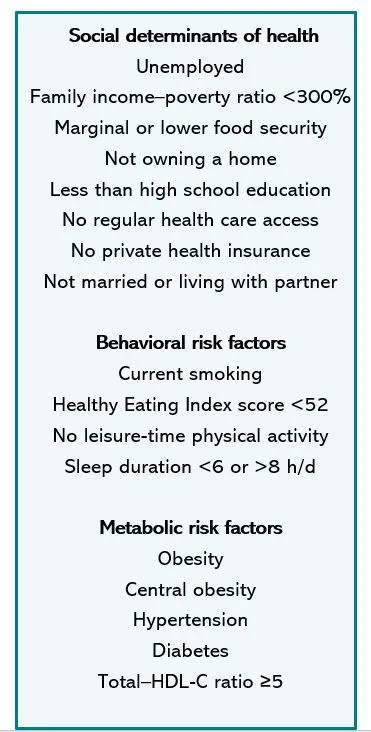The persistent greater prevalence of cardiovascular disease (CVD) mortality among Black adults compared with White adults is driven significantly by effects of social determinants of health (SDOH), according to a new study led by researchers from Tulane University.1 The findings were published online August 14 in the Annals of Internal Medicine.

Using data from the National Health and Nutrition Examination Survey (NHANES) 1999 to 2018, for more than 50 000 individuals the investigators found that difference between Black and White CVD mortality diminished after statistically controlling for traditional CVD risk factors; when adjustments were made for SDOH, the difference became negligible.
Although CVD-related mortality has declined in the US, in 2019 the age-adjusted rate was 32% higher for Black women and 33% higher for Black men than for White women and men, according to study authors. Racial and ethnic disparities in CVD are well documented, they add, with prevalence of CVD risk factors such as hypertension, obesity, and diabetes historically higher among the Black population. Prospective studies have found SDOH linked to both CVD risk factors and events and socioeconomic status associated with racial differences in CVD mortality.
There is little research, however, “on the complex relationship of social, behavioral, and metabolic risk factors with racial differences in CVD mortality in a large, nationally representative sample in the US population,” Jiang He, MD, PhD,a professor of epidemiology at Tulane University’s School of Public Health and Tropical Medicine, and colleagues wrote. “Such information may be critical to guide the development of national public health policies for targeted interventions aimed at eliminating health disparities in CVD mortality.”
The objective of their study was to investigate associations of social, behavioral, and metabolic risk factors with CVD mortality and then analyze the extent to which racial differences in CVD mortality persisted after accounting for those risk factors in a large, diverse US population.
The research team collected NHANES survey data on 50 808 US adults aged ≥20 years. CVD mortality was determined from linkage to the National Death Index through 2019.
FINDINGS
Confirmed CVD deaths over an average of 9.4 years numbered 2589 of which 537 were in Black individuals, according to the findings. The overall age- and sex-standardized CVD mortality rate was 383 deaths (95% CI, 343.4-428.9) per 100 000 person-years.
Among population subgroups, He and colleagues found this rate was highest among Black adults (484.7 deaths; 95% CI, 397.3-599.1) followed by White adults (384.5 deaths; 95% CI, 338.3-441.6), Hispanic adults (292.4 deaths; 95% CI, 217.8-402.7), and adults in other racial/ethnic groups (255.1 deaths; 95% CI, 143.0-510.2).
The team reported that in the study subset of Black and White individuals, the age- and sex-adjusted hazard ratio (HR) of CVD mortality of Black compared with White individuals was 1.54 (95% CI, 1.34-1.77). Adjustment in the 3 separate models for metabolic, behavioral, and SDOH risk factors reduced the HR for the difference between Black and White participants as follows:
- Metabolic 1.34 (95% CI, 1.16-1.55)
- Behavioral 1.31 (95% CI, 1.15-1.5)
- SDOH 1.04 (95% CI, 0.9-1.21)
Behavioral risk factors included smoking, a lack of physical activity and sleep duration of <6 hours or>8 hours; metabolic risk factors included hypertension, obesity, and diabetes.
The SDOH factors linked to a significantly greater risk for CVD mortality independently of behavioral and metabolic risk factors included unemployment, low family income, food insecurity, a lack of home ownership and not being married to or living with a partner.
The SDOH factors linked to a significantly greater risk for CVD mortality independently of behavioral and metabolic risk factors included unemployment, low family income, food insecurity, a lack of home ownership and not being married to or living with a partner.
The investigators suggested that living with a partner may be a “proxy for several important factors, including greater social support and a healthier lifestyle.”
“For so many years we have focused on smoking, diet, physical activity, obesity, hypertension, diabetes, and high cholesterol – and we know those are important for the prevention of cardiovascular disease – but it surprised me that the Black-White difference in cardiovascular disease mortality is mainly due to social factors,” said He in a Tulane press statement.2
Among the study’s limitations, the authors wrote, are the cross-sectional collection of metabolic risk factors which precluded causal ordering with CVD mortality. They also point out that the number of stroke- and heart disease-related deaths was too small to conduct a cause-specific analysis.
He and colleagues concluded that more research is needed “to understand the underlying mechanisms of SDOH on CVD mortality and develop novel community-based interventions interventions for reducing CVD risk in Black populations.”

